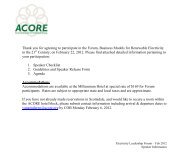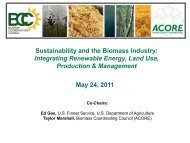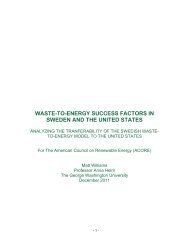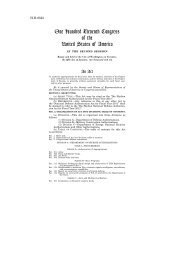We can and will [solve the climate crisis]and it begins in our cities.– Jerome Ringo, President, Apollo AllianceJerome Ringo cited the failure of local and nationalleadership to raise awareness about energy issues. Howto increase popular awareness of the importance of cleanenergy and energy efficiency is one of the biggest challengesAmerica faces.The damaging effects of global warming are often feltmost by the poorest communities, whose voices in theenvironmental movement are rarely heard. The UnitedStates has the opportunity to engage low income communitiesby training people from all walks of life for jobsbettering their environment.The poor are deeply affected by negativeenvironmental factors, and have significantlyless power to combat these changes.The poor are more occupied with daily life and theirimmediate future than wealthier <strong>American</strong>s. They haveless money to invest in alternative energy, and mustspend 50% of their disposable income on fossil fuelgeneratedenergy. A disproportionate number ofimpoverished students are affected by infrastructureinefficiency and degradation at their schools and homes,as there are drastically more health issues—like a higherpercentage of children with asthma, or dangerous levelsof lead in children’s bloodstreams—in older anddilapidated buildings.The stimulus bill presents an once-in-a-lifetimeopportunity for energy and the environment tobe placed in the forefront of the <strong>American</strong>education system.Now that the <strong>American</strong> Recovery and Reinvestment Act of2009 has been passed and signed into law, there is aunique chance for educators and administrators to settheir agendas, curricula, and plans around renewableenergy and energy efficiency. This is the time for schoolsto create holistic and grand strategies to greatly reducetheir carbon footprints and greenhouse gas emissions.Teachers need to be well-versed and confidentin leading environmental education lessons, andneed to exude a green lifestyle themselves.The administrators of a green school should look toemploy teachers of all subjects who have studied or havea background in environmental science, sustainability, orgreen design. The school can provide training for teachersin specific “green” areas, or in particular lessons thatthey may not be familiar with. Teachers andadministrators should also understand the green featuresof their school.Green BuildingsBuildings should look to other forms of energygeneration, such as distributed generation andon-site generation from renewable sources.Agreen building can greatly decrease itsenergy usage from fossil fuels with theadoption of energy generation from solar, wind,or geothermal resources on site. By havingdistributed combined-heat-and-powergeneration systems installed, buildings cangreatly increase their efficiency.There are real barriers to entering the greenbuildings arena, so the process to receive siting,zoning, and planning permits needs to be madeeasier.The federal government has a real obligation to facilitatethe requests of, and issuing of permits on green buildingprojects. There are real challenges that have to be facedin the process of installing new energy generationsystems, including net metering limitations, third-partyownership of renewable energy generation equipment,and interconnection fees to the electric grid.The planners and designers of a green school,or any green building, should know their assetsand try to utilize their natural resources.In the case of the University of Minnesota-Morris, therewas huge wind potential in the western part of the stateas well as agricultural waste that the school began buyingand using in a biomass gasification generator. Theuniversity also put up a large, 1.65 MW wind turbine andis about to begin construction on another turbine ofsimilar size. Minnesota-Morris was able to utilize theirlocal resources to maximize the amount of renewableenergy on their campus.<strong>American</strong> <strong>Council</strong> <strong>On</strong> <strong>Renewable</strong> <strong>Energy</strong>Executive Summary Report 28
Green construction and renovation should beviewed as a life-cycle cost rather than an initialupfront cost.Nearly all of the energy and monetary savings from agreen building will be accumulated as the facilitymatures. The assumption that a green building will have ahigher upfront cost is generally true, yet usually this costis not significantly greater. Nonetheless, the initial costsof a green building may be more expensive than a schoolbuilt to code, but added expenses will be paid off throughconservation, efficiency, and renewables—not just once,but many times over—during the lifetime of the building.Efficient use of energy in buildings is one of themost effective ways to drastically reducegreenhouse gas emissions.Mary Tucker, <strong>Energy</strong> Program Manager, City of San Jose,California spoke about the city’s use of green goals toboth reduce greenhouse gas emissions and stimulate thelocal economy. Green buildings play a large role incurbing municipal emissions and can be responsible for a60% reduction in carbon emissions. <strong>Energy</strong> efficiencyprograms in city buildings spell huge monetary savings forcities, with projects at sixteen San Jose buildingsexpected to save $435,000 in general fund energy costs.Green SchoolsAttendees shared a vision that every studentattend a green school within one generation.Roughly 20% of the <strong>American</strong> population,including students, teachers, andadministrators, go to school every day, so thereis huge potential to affect millions of lives withgreen schools. By the time that today’s childrenare sending their children to school, a greenschool should be the standard building practice.A green school in operation saves energy and money.Over the course of a year, a typical new green school willuse only 2/3 of the energy that a school built to today’scode would use. An average green school will also savearound $100,000 per year in operations comparison toan ordinary school. This savings means that greenschools would have the available funding to hire a fewnew, well-qualified teachers each year.Every state should mandate green school requirements.There are currently 10 states that have instituted someform of green building regulations for new schoolconstruction, and/or for existing school renovations.Another 17 states are in the process of passing similarrequirements. The United States’ Green Building <strong>Council</strong>(USGBC) encourages a goal for all 50 states to pass andimplement green school legislation. <strong>On</strong> Capitol Hill, thegreen schools caucus is one of the fastest growingfederal movements.A concerted effort on the state level can lead tobold and influential green school policy.State governments will play an important role in theexpansion and pervasiveness of green schools. Forexample, Ohio has made a commitment to build 205green schools over the next two years. Studies estimatethat these schools will save the state $1.4 billionannually on energy consumption, and nearly 1/3 of allnew school construction costs will be recouped. Fromthese savings, the state can pay for the salaries of newschool staff. As another benefit, it has been shown thatthe retention rate among teachers in green schools ishigher than in other, traditional schools.A green school should be an interactive buildingand encourage a hands-on learning experience.Of equal importance to constructing a green school islabeling the special design features of the school.Labeling facilitates class lessons on these features,integrating seamlessly with the students’ education. Forexample, features such as reclaimed and reused woodfrom an old factory should have appropriate signage forstudents to read, or there should be diagrams explaininghow the low-flush toilets in the bathrooms work.Lastly, students should have access to the data from anon-site renewable energy installation. There could be, forexample, touch-screen equipment in a public area of theschool (i.e. the library or main foyer), which displays theoutput from the solar photovoltaic array on the roof.If both the public and private sector decided toprioritize and incentivize the building of greenschools, green schools would proliferate.<strong>On</strong>e of the largest factors in the proliferation of greenschools is the reception of assistance from the utilitycompanies. It would be very beneficial to the green schoolmovement if utilities could alleviate some of the operationalcosts from green schools’ renewable energy<strong>American</strong> <strong>Council</strong> <strong>On</strong> <strong>Renewable</strong> <strong>Energy</strong>Executive Summary Report 29
- Page 6: The highlights of WIREC 2008 includ
- Page 9 and 10: EVENT SPONSORSHosted byBadge Sponso
- Page 11 and 12: EXHIBITORS ContinuedKamatics Corp.K
- Page 13 and 14: The ARRA contains the following ite
- Page 15 and 16: “How do we organize ourselves to
- Page 17 and 18: John GeesmanFormer Commissioner, Ca
- Page 19 and 20: Cathy ZoiCEO, Alliance for Climate
- Page 21 and 22: John CavalierManaging Partner, Huds
- Page 23 and 24: BiofuelsChristopher Groobey, Partne
- Page 25 and 26: Patrick Cloney, Executive Director,
- Page 27 and 28: Gal Luft, Executive Director, Insti
- Page 29 and 30: Daniel Kammen, Class of 1935 Distin
- Page 31 and 32: Biomass, Biofuels, and Advanced Veh
- Page 33 and 34: Critical development opportunities
- Page 35 and 36: ConclusionsSpeakers at RETECH 2009
- Page 37 and 38: Geothermal PowerOverviewThe United
- Page 39: Green Buildings and CommunitiesOver
- Page 43 and 44: Session ReferencesGreen Schools Bre
- Page 45 and 46: 1. The local electric power market
- Page 47 and 48: International Renewable Energy Indu
- Page 49 and 50: production was 37%; the domestic tu
- Page 51 and 52: There have been a number of incenti
- Page 53 and 54: educes mortality and improves gende
- Page 55 and 56: D7 - ChinaJing Su, Director of US-C
- Page 57 and 58: past, uncertain legislative environ
- Page 59 and 60: marketplace, accelerating and deepe
- Page 61 and 62: • Complexity and operating costs
- Page 63 and 64: C6 - Environmental and Carbon Finan
- Page 65 and 66: The technology debate: thin film ve
- Page 67 and 68: FITs have grown in popularity over
- Page 69 and 70: Haroula Reitz, Global Manager of Sc
- Page 71 and 72: Currently, planning is geographical
- Page 73 and 74: Federal policy should allow for a c
- Page 75 and 76: Wind: Markets, Technologies, and Po
- Page 77 and 78: Regional FactorsBesides federal pol













